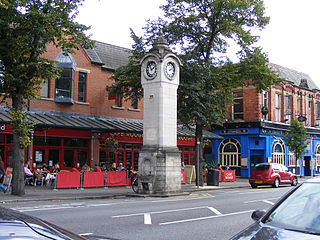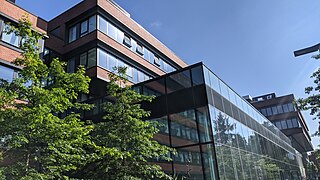
The University of Manchester Institute of Science and Technology (UMIST) was a university based in the centre of the city of Manchester in England. It specialised in technical and scientific subjects and was a major centre for research. On 1 October 2004, it amalgamated with the Victoria University of Manchester to produce a new entity called the University of Manchester.

Manchester Metropolitan University (MMU) is located in the centre of Manchester, England. The university has over 40,000 students and over 4,000 members of staff. It is home to four faculties and is one of the largest universities in the UK, measured by the size of its student population in 2020/21.

Rayon, also called viscose and commercialised in some countries as sabra silk or cactus silk, is a semi-synthetic fiber, made from natural sources of regenerated cellulose, such as wood and related agricultural products. It has the same molecular structure as cellulose. Many types and grades of viscose fibers and films exist. Some imitate the feel and texture of natural fibers such as silk, wool, cotton, and linen. The types that resemble silk are often called artificial silk. It can be woven or knit to make textiles for clothing and other purposes.
Synthetic fibers or synthetic fibres are fibers made by humans through chemical synthesis, as opposed to natural fibers that are directly derived from living organisms, such as plants or fur from animals. They are the result of extensive research by scientists to replicate naturally occurring animal and plant fibers. In general, synthetic fibers are created by extruding fiber-forming materials through spinnerets, forming a fiber. These are called synthetic or artificial fibers. The word polymer comes from a Greek prefix "poly" which means "many" and suffix "mer" which means "single units"..

Didsbury is a suburb of Manchester, England, on the north bank of the River Mersey, 5 miles south of Manchester city centre. The population at the 2011 census was 26,788.

Daniel Adamson was an English engineer who became a successful manufacturer of boilers and was the driving force behind the inception of the Manchester Ship Canal project during the 1880s.
Courtaulds was a United Kingdom-based manufacturer of fabric, clothing, artificial fibres, and chemicals. It was established in 1794 and became the world's leading man-made fibre production company before being broken up in 1990 into Courtaulds plc and Courtaulds Textiles Ltd.

Manchester Institute of Innovation Research (MIoIR) is a research institute based in Alliance Manchester Business School at the University of Manchester, UK. MIoIR is a centre of excellence in the fields of innovation studies, technology management and innovation management, science policy, technology policy, innovation policy and regional innovation, the study of emerging technologies, responsible research and innovation, and research into socio-technical transitions with a focus on sustainability and digital transitions. MIoIR has also been known for research on service innovation and in particular the definition and early exploration of the concept of knowledge-intensive business services, through the work of scholars such as Ian Miles and Bruce Tether.
William Lawrence Balls, was a British botanist who specialised in cotton technology. He was elected a Fellow of the Royal Society in 1923.

Arthur James Turner, CBE, FTI was a British scientist who worked in the field of textile technology. He was the first director of the Technological Laboratory created by the Indian Central Cotton Committee (ICCC) in Bombay in 1924. He was awarded the Warner Memorial Medal by the Textile Institute in 1931 in recognition of outstanding work in textile science and technology and was appointed to the CBE in 1950.

The British Cave Research Association (BCRA) is a speleological organisation in the United Kingdom. Its object is to promote the study of caves and associated phenomena, and it attains this by supporting cave and karst research, encouraging original exploration, collecting and publishing speleological information, maintaining a library and organising educational and scientific conferences and meetings.

The Towers is a research establishment for new technologies in cotton production. The Shirley Institute was established in 1920 at a cost of £10,000 to accommodate the newly formed British Cotton Industry Research Association. It is a Grade II* listed building in the suburb of Didsbury, located 6 miles (10 km) south of the centre of Manchester, England.
The Cotton Board was an organisation to oversee the organisation, research, marketing and promoting the cotton textile industry mainly based in Lancashire and Glasgow. It existed from 1940, and as a statutory Industrial Development Board from 1948 to 1972, known in its last years as the Textile Council.
The British Rayon Research Association was a research institute formed in 1946 by the British Rayon Federation and others. It was funded by the Department of Scientific and Industrial Research and by voluntary funds from industry to investigate the chemical and physical properties of rayon and rayon fabrics, using a wide range of laboratory and theoretical methods. John Wilson, who was its Director from 1948 to 1958 was appointed a CBE for his work at the BRRA. It was located near Ringway Airport in Manchester, initially, and then at Heald Green near Manchester after 1955.
Leonard Albert Wiseman OBE BSc ARI.C CText FTI was an organic chemist, scientific intelligence analyst and scientific administrator. Following his early work as a research chemist and in intelligence, he became, successively Deputy Director of the Atomic Weapons Research Establishment, Director of the British Rayon Research Association, succeeding John Wilson, Deputy Director of the Cotton, Silk and Man-made Fibres Research Association when the BRRA merged with the British Cotton Industry Research Association, becoming Director in 1969 until retiring in 1980. He also served for some years as Chairman of Council of the Textile Institute.
The Wool Industries Research Association was an industrial research organization in the United Kingdom. It later became the Wira Technology Group before being merged with the Shirley Institute in the 1989 to form the British Textile Technology Group. It was funded by a levy raised under powers from the Industrial Organisation and Development Act 1947 through the Wool Textile Research Council, established in 1950.

The Calico Printers' Association Ltd was a British textile company founded in 1899, from the amalgamation of 46 textile printing companies and 13 textile merchants. The industry had prospered in the latter half of the 19th century but the fierce competition led to a decline in quality and profit margins. Most of the leading companies in the industry decided to amalgamate in order "to preserve the tradition and standing of calico printing and to produce textiles of a high standard at reasonable prices." The company at its inception accounted for over 80% of Britain’s output of printed cloth.

Kearsley Mill is a 240,000 sq ft (22,000 m2), late period cotton mill located in the small village of Prestolee in Kearsley, Greater Manchester, part of the historic county of Lancashire. A near complete example of Edwardian mill architecture, the building now functions as headquarters for a number of businesses and is still used in the continued manufacturing and distribution of textiles by Richard Haworth Ltd Est (1876), part of the Ruia Group. The mill is a Grade II listed building.
William Greenwood was Conservative MP for Stockport from 1920 to 1925. He was first elected in the 1920 Stockport by-election, and was re-elected in the General Elections of 1922, 1923 and 1924. He died in office, causing the 1925 Stockport by-election.
Mary Corner, was a pharmacist, a worker in the British Cotton Industry and British Leather Manufacturers, Head of the Micro-analytical Section of the Chemical Research Laboratory, Vice-Chairman of the Microchemistry group and a founding member of the Microchemical Club.











